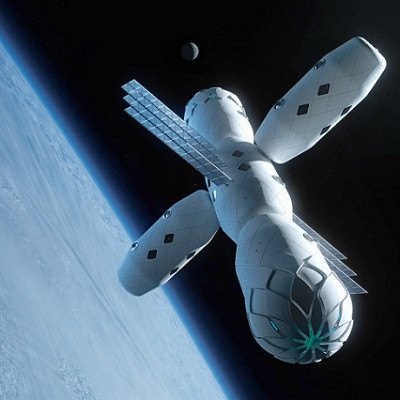An international team led by Dr. Vivek Koncherry at The University of Manchester is developing a prototype for the graphene-enhanced space habitat. According to Koncherry, who we reached out to by email, the material will help balance the massively contrasting temperatures to which a space structure is subjected, making it safer for its future inhabitants.
"In a space structure, there is extreme temperature variation on opposite sides. Graphene is the best thermally conductive material, and we can take advantage of this property to balance the heat difference," Koncherry says. "In addition, graphene toughens the material, improving damage resistance caused by micrometeoroids and space junk."

The University of Manchester team's space habitat is intended for low Earth orbit.
The University of Manchester team is collaborating with global architecture firm Skidmore, Owings & Merrill (SOM), the architects behind the world’s tallest building, Burj Khalifa in Dubai, to develop the space habitat, which is intended for low Earth orbit. Another University of Manchester researcher, Dr. Aled Roberts, recently proposed a very different material, human blood, as a binding agent that could strengthen space habitats on a future resource-deprived Mars colony.
Space graphene research has applications here on Earth
The University of Manchester team's scaled prototype will be composed of pressurized vessels designed to function in space, though their work also has applications on Earth, Koncherry says: "there are several applications, particularly civil constructions on Earth, where graphene can be used in composites for beams, rods, facades, etc. Graphene can also help improve the properties of recycled materials for construction applications."

Space agencies aim to have an expanded permanent presence in space in the future.
In a press statement, Daniel Inocente, SOM's senior designer in New York said that "conducting research using graphene allows us to test lightweight materials and design processes that could improve the efficacy of composite structures for potential applications on Earth and future use in space." Other graphene innovations have also made headlines in recent months, including the world's first graphene-infused road resurfacing on the UK's A1 motorway and the material's ability to massively boost sodium-ion battery capacity.
With space agencies such as NASA, Roscosmos, and the European Space Agency (ESA) aiming to initiate a permanent presence in space in the coming years with projects such as the lunar Gateway and the Artemis moon landings, the race is on to build safer habitats that efficiently incorporate life support systems. Koncherry says that he and his team are hard at work on the first scaled model of their space habitat prototype, and once that is completed they will collaborate with space agencies to manufacture a full-scale model that can be launched into orbit for space trials.
Read the original article on Interesting Engineering.
